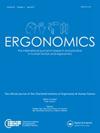在一系列与军事相关的步行速度下,负载搬运过程中武器操作的影响。
IF 2
3区 工程技术
Q3 ENGINEERING, INDUSTRIAL
引用次数: 0
摘要
本研究调查了武器搬运对负重期间生理反应和行走步态的影响。17 名士兵在跑步机上以递增速度(3.5、5.5、6.5 km.h-1,自选)负重 23.2 千克完成了四次为期 12 分钟的跑步,同时选择了携带武器或不携带武器。每次试验都对生理、感知和生物力学结果进行了测量。在加载反应和挥杆中段,观察到髋关节屈伸与武器速度的交互作用(p < .05)。在 6.5 km.h-1 时,武器操作会提高心肺反应(p < .05)。在通气、氧脉搏、努力感、步长和起趾时膝关节屈伸方面,观察到武器操作的主效应(p < .05)。在其他生物力学指标方面,没有观察到武器操作的主要效应。这些研究结果表明,搬运武器时的生理和生物力学反应可能与步行速度有关。研究人员在负载搬运过程中以递增速度对生理和生物力学反应进行了评估。尽管生物力学原理相似,但步行速度越快,生理需求越大,这表明等长肌肉收缩对武器稳定的贡献越大。本文章由计算机程序翻译,如有差异,请以英文原文为准。
The effect of weapon handling during load carriage across a range of military-relevant walking speeds.
This study investigated the effects of weapon handling on the physiological responses and walking-gait kinematics during load carriage. Seventeen soldiers completed four twelve-minute bouts of treadmill walking at incremental speeds (3.5, 5.5, 6.5 km.h-1 and self-selected) carrying 23.2-kg of additional load, while either handling a weapon or not handling a weapon. Physiological, perceptual and biomechanical outcomes were measured throughout each trial. A weapon-by-speed interaction (p < .05) was observed for hip flexion-extension during loading response and mid-swing. Weapon handling elevated (p < .05) cardiorespiratory responses at 6.5 km.h-1. Main effects (p < .05) of weapon handling were observed for ventilation, oxygen pulse, effort perception, stride length and knee flexion-extension during toe-off. No main effects of weapon handling were observed for any other biomechanical measures. These findings demonstrate that physiological and biomechanical responses to weapon handling are likely walking-speed dependent.Practitioner summary: Weapon handling is an important part of many load-carriage tasks but is rarely investigated. Physiological and biomechanical responses were assessed at incremental speeds during load carriage. Despite similar biomechanics, there was greater physiological demands at faster walking speeds, suggesting an increased contribution from isometric muscle contractions for weapon stabilisation.
求助全文
通过发布文献求助,成功后即可免费获取论文全文。
去求助
来源期刊

Ergonomics
工程技术-工程:工业
CiteScore
4.60
自引率
12.50%
发文量
147
审稿时长
6 months
期刊介绍:
Ergonomics, also known as human factors, is the scientific discipline that seeks to understand and improve human interactions with products, equipment, environments and systems. Drawing upon human biology, psychology, engineering and design, Ergonomics aims to develop and apply knowledge and techniques to optimise system performance, whilst protecting the health, safety and well-being of individuals involved. The attention of ergonomics extends across work, leisure and other aspects of our daily lives.
The journal Ergonomics is an international refereed publication, with a 60 year tradition of disseminating high quality research. Original submissions, both theoretical and applied, are invited from across the subject, including physical, cognitive, organisational and environmental ergonomics. Papers reporting the findings of research from cognate disciplines are also welcome, where these contribute to understanding equipment, tasks, jobs, systems and environments and the corresponding needs, abilities and limitations of people.
All published research articles in this journal have undergone rigorous peer review, based on initial editor screening and anonymous refereeing by independent expert referees.
 求助内容:
求助内容: 应助结果提醒方式:
应助结果提醒方式:


